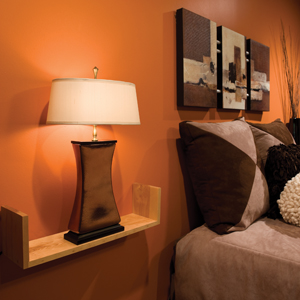 |

For a bedroom, you will want to achieve a relaxing, calming or even romantic mood. Photo: Thumprints
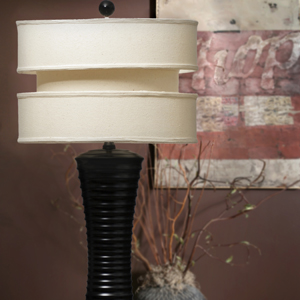
A white shade will give off more light than a darker shade. Photo: Thumprints
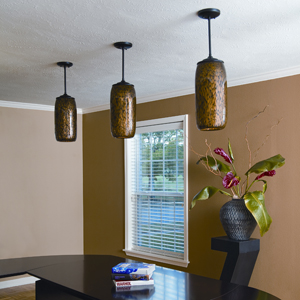
Typically, overhead lighting is used in kitchens for task lighting. Photo: Thumprints
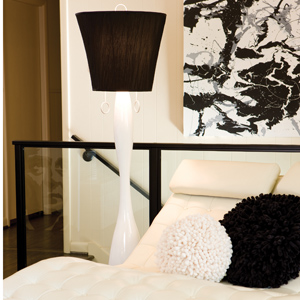
Varying the heights of light fixtures will enhance the illumination in the room. Photo: Thumprints
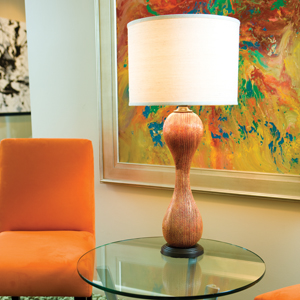
When it comes to lighting, most styles, finishes and shapes can work in any room. Photo: Thumprints
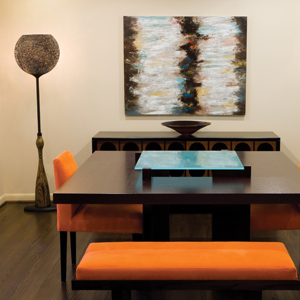
Lamps typically give off a softer light than overhead lighting. Photo: Thumprints
Lamps typically give off a softer light than overhead lighting. Photo: Thumprints
Design Tips from a Lighting Expert
Allison West, owner and designer for Thumprints, a specialty lamp-making company offers more tips for getting the most from your lighting:
- Combine overhead lighting and lamps in a room.
- Place lamps throughout a room. The more lamps you have in a room, the more options you will have. You may want a certain area of a room brightly lit for reading and another area dimly lit for relaxing. If you want to achieve a relaxed or romantic setting, dim overhead lights and light some lamps or use lamps alone. Lamps typically give off a softer light than overhead lighting.
- Consider colored lampshades. The color of a lampshade makes a dramatic difference in the mood of light it spreads. A white shade will give off more light than a darker shade. Typically, lighter shades are best for reading or main light sources for a room, while lamps with darker shades are often designed for ambiance or mood lighting.
-
Illuminating Your Lighting Options
Want to light up a room? These shopping and décor tips will show you how.
- by Mary Best
For most of us, shopping for lighting can be intimidating. It’s hard to know how certain types of lighting will look in a particular room because, like paint, light fixtures can look differently in a store than they do in a home. And as anyone who has shopped for lighting knows, the number of alternatives can be overwhelming.
The beauty of today’s lighting options, however, is that there’s truly something for everyone. With the variety of styles, sizes, materials and prices available, there’s a lighting solution for every area of your home. And when used successfully, light fixtures can reflect your personality, accent specific pieces or areas of a room, and add artistic flair to your home.
If you're ready to update your home's décor with new lighting, here are some helpful shopping tips to help you find just what you're looking for:
Exploring the Selection
Because there are many types of lighting, one of the biggest challenges is deciding what will work best in a particular room. When looking at the area you want to light, consider whether you need overhead lighting, hanging light fixture, wall sconces, a table lamp, a floor lamp or task lighting.
“The best way to use different types of lighting in a room is to combine them,” says Allison West, owner and designer for Thumprints, a specialty lamp-making company. For example, West explains that you can place a floor lamp behind a sofa to light a corner, a table lamp on an end table for reading and a chandelier in the middle of a room for overhead or dramatic lighting. Varying the heights of these light fixtures will enhance the illumination in the room.
While multiple lights in the same room don’t have to match, they should have some continuity and sense of balance. One way to accomplish this is to pair lamps that share the same color scheme but have different shapes, suggests West. “For example, you can use two pottery lamps with the same base and shade colors, but different body and shade styles as bedside table lamps.”
Another way to coordinate lighting is to use lamps with similar styles. Placing these together gives a room a fresh and unique look, while still maintaining a sense of balance.
Creating a Mood with Lighting
More than merely an accessory, lighting can change a room’s ambiance, the appearance of its contents and even its purpose. Start by evaluating the functionality of your room to help you define its mood.
“A kitchen is a task room,” says West, “so use lots of light. Typically, overhead lighting is used in kitchens for task lighting. For a bedroom, you will want to achieve a relaxing, calming or even romantic mood. This can easily be achieved by the use of dimmers on overhead lighting or by the use of lamps.”
Think Creatively
By thinking creatively, most styles, finishes and shapes can work in any room. “I love using hanging lights in unexpected places,” says West. “Pendants with large shades are great to use in place of bedside or end table lamps because they free up space on the tables. … People do not typically think of putting a floor lamp in a bathroom or a kitchen, but a tall torchiere light can give a small bathroom just enough light—or it can perfectly light a kitchen nook.”
Another key to successful light planning is evaluating the amount of natural light available. Be sure to notice how much natural light you have from windows and how the light differs at different times of the day. This will dictate the type of lighting you need and how many lighting sources each room will require.
The Green Glow
Many lighting manufacturers are now using energy-efficient light sources such as LED lighting or light-emitting diodes. Their popularity is on the rise because they consume less energy, last longer and are easier to change. “It will take time for everyone to realize the true benefits of using energy efficient lighting for long-term financial savings and, most importantly, to help save our environment,” says West.

